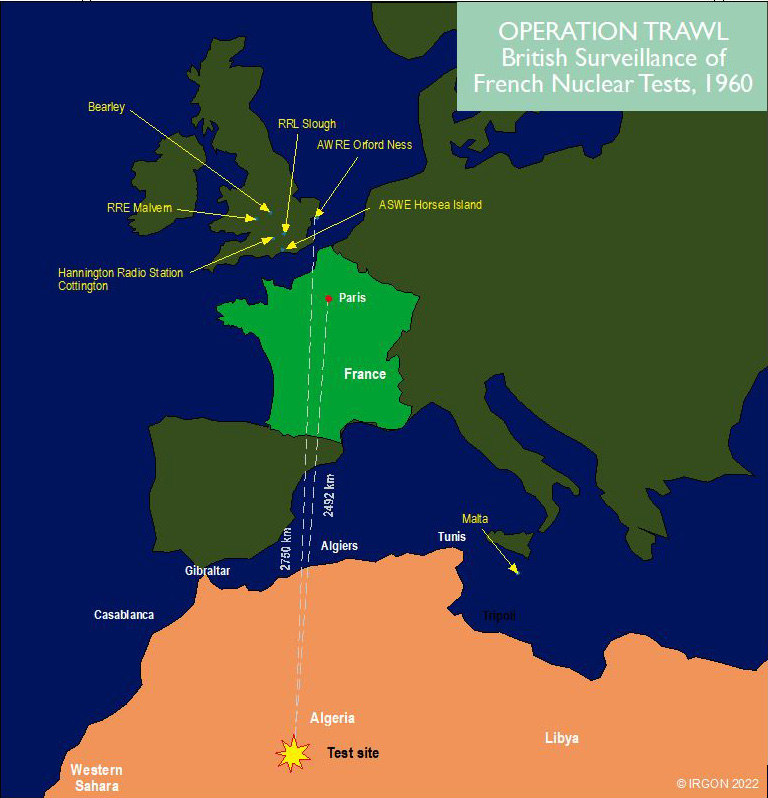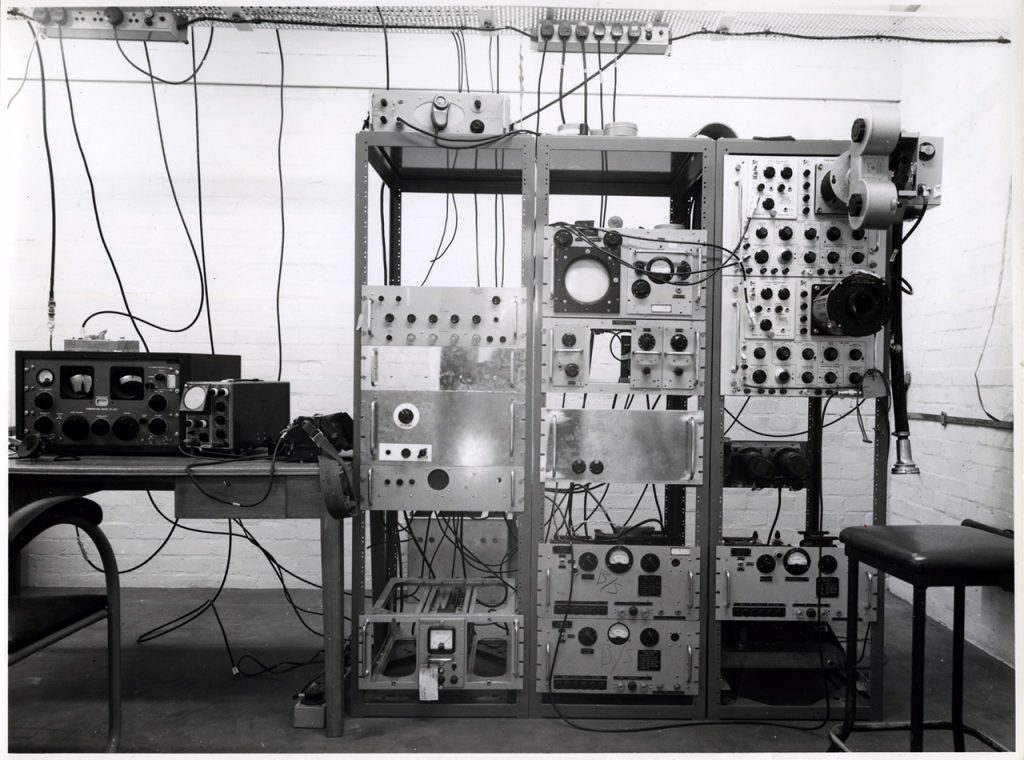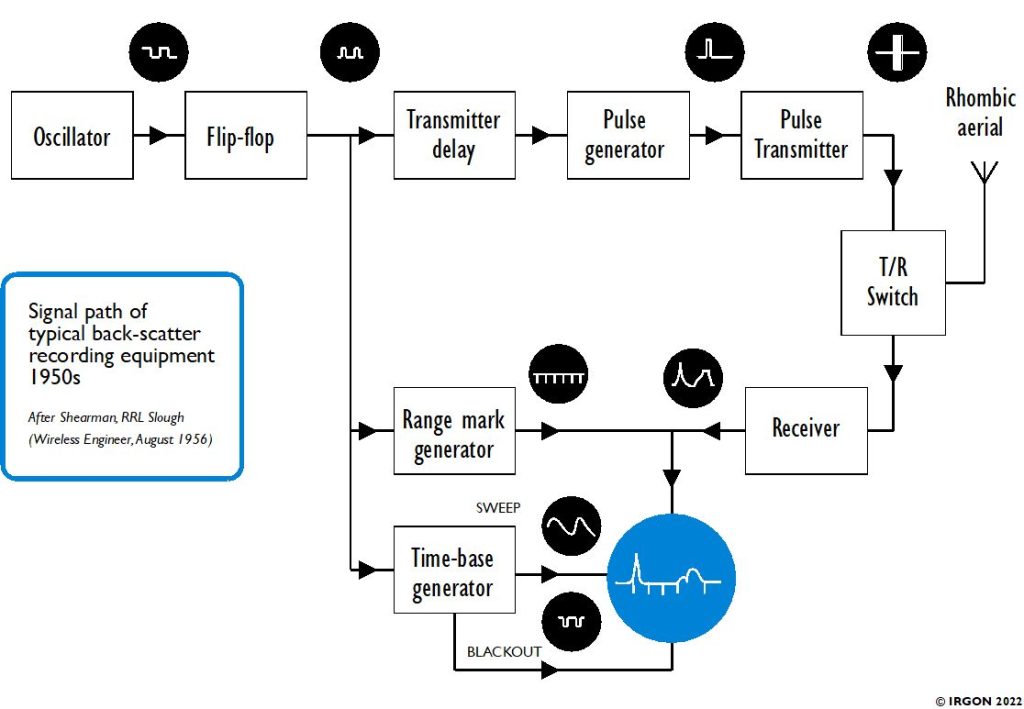
Introduction: detection of atomic explosions via electronic methods
The fact that an electromagnetic pulse is produced by a nuclear explosion was known from the earliest days of nuclear weapons testing. 1
- During the Trinity test, Enrico Fermi expected the electrical effects to be equivalent to a large bolt of lightning striking the vicinity. All signal lines were completely shielded, in many cases doubly shielded. 2
- Early British nuclear tests resulted in some instrumentation failures, attributed to “radio flash”.
The first remote electronic detection of a nuclear explosion was probably made in April, 1948 during Operation Sandstone. The instrumentation company EG&G (Edgerton, Germeshausen and Grier) were working on test instrumentation in the Pacific Proving Grounds at Eniwetok. One of their engineers back at their home base in Boston, being aware of the exact time of the planned detonation, was able to pick up a signal on an oscilloscope furnished with a makeshift antenna. 3
Various electromagnetic phenomena can be exploited, giving rise to several detection methods which can be used, including telluric currents, magnetic field measurements, VLF phase anomalies, and HF backscatter radar. This latter method was the one employed on Orford Ness.
By the late 1950s, a whole spectrum of detection methods had evolved. Airborne radiochemical sampling, changes in earth’s magnetic field, air fluorescence, telluric current and seismic measurements were all being developed as detection techniques.
Britain was in the advantageous position of having results of electromagnetic observations on a number of its own nuclear tests. At least since Operation BUFFALO in 1956, specific measurements were being made to quantify what was then referred to as “radio flash”, now generally referred to as electromagnetic pulse (EMP). These electromagnetic measurements were made in parallel to a number of others, like air pressure fluctuations, ground shock measurements, radiological and thermal variables.
Following the atmospheric test moratorium coming into force in November 1958, remote monitoring of nuclear explosions gained a new importance as a means of verification. In the United States, the U.S. Air Force had activated AFTAC (Air Force Technical Applications Center) in 1959 to prepare to monitor compliance with upcoming test bans. This organisation co-sponsored a surveillance system which was later installed on Orford Ness (another IRGON article is in preparation, Nuclear Test Detection Phase 2). However in the late 1950s and early 1960s the British were dependent on home-grown equipment. The responsibility for monitoring of atomic testing fell under the auspices of the Atomic Weapons Research Establishment. One of the leading workers in the field at AWRE Aldermaston, S. D. Abercrombie, stated that the UK decided to concentrate its efforts on the detection of atomic weapons from ground based stations, given that it had no satellite programme of its own at that time. 4
Detection by high frequency backscatter
The HF backscatter method uses high frequency radio waves which have the property of bouncing off the ionosphere. To detect nuclear explosions beyond the horizon (or other transient events like missile launches), a method is needed to deal with the static clutter inherent in this technique.
Initially, on Orford Ness a photographic integration method was used. Later equipment (see the subsequent article on Nuclear Detection Phase 2, in preparation) used more refined methods.

The French nuclear ambition and British monitoring efforts

France’s intentions regarding acquisition of nuclear weapons were monitored by the US and the UK since the end of WW2.
Tabs were kept on the scientists and staff involved, and their political leanings. In the US, scientists of the calibre of Joliot-Curie inspired suspicion because of political activities.
From the early 1950s, he UK and US had a joint measurement programme to monitor global plutonium production. 5
The CIA’s monthly Central Intelligence Bulletin dated June 1957 noted that French plutonium “in weapons quantities is now becoming available”, no doubt based on the UK/US measurement programme. 6
The Americans made at least one U-2 overflight of France, and photographic evidence had also been obtained from covertly placed cameras on commercial airliners. 7
The British had broken into the high-level cypher between the Quai d’Orsay and the French Embassy in London. Nuclear information gleaned by this channel was passed to the US. 8
Finally, there is evidence that the Americans had an informant embedded in the senior scientific team which was sent to North Africa. 9
French atmospheric testing in the Sahara

Timeline of French atmospheric tests in the Sahara
Choice of the test site
France announced her intention to test nuclear weapons in the Sahara during 1959. 10
After studying Réunion, New Caledonia, and Clipperton Island, General Charles Ailleret, head of the Special Weapons Section, proposed two possible nuclear test sites for France in a January 1957 report: French Algeria in the Sahara Desert, and French Polynesia.
Although he recommended against Polynesia because of its distance from France and lack of a large airport, Ailleret stated that Algeria should be chosen “provisionally”, likely due in part to the Algerian War, which was in full swing at this time. 11
The chosen site, Reggane, was a long way from the places where incursions were taking place (the French had constructed the ligne Morice, a defensive line using radar, minefields and electric fences, a lower-tech precursor to McNamara’s Fence). Distance from Reganne to Tebessa near the border with Tunisia is 1200 km.
The CIA was aware of the planned test site in 1958. 12

Reproduction of a CIA map showing the location of the Saharan test site
British monitoring efforts
There was sufficient warning of the French nuclear intentions for the British to examine a number of potential observation sites outside the UK.
The British were able to bring their expertise to bear in the field of electronic detection (Operation TRAWL), airborne sampling (Operation MEDSTEAD) and other methods, including radiological monitoring programmes in West Africa.
Operation TRAWL
The nearest overseas British base with usable logistics and security was Malta. A complete monitoring station was flown out in July 1959, and installed at Dingli.
Six further observation sites were located on UK soil.
Three classes of electromagnetic measurements were planned from the UK bases, these being:
- The effect of the explosion at ground level by direct measurements of radio signals.
- The effect on the ionosphere, which can be measured by high frequency radio techniques.
- The effect, if any, on earth currents produced in the ground and magnetic anomalies.


* The frequency in use at RRE Malvern has not been established to date.
The setup on Orford Ness
Once notice had been received early in 1959 that a detection setup was needed on Orford Ness, Keith Wood, the Superintendent, and his staff worked out a scheme to detect the anomalies caused by a nuclear explosion using HF backscatter 13.
They erected a large aerial in a north-south alignment and set up their equipment in the building known as the Plate Store, or Building 84. This aerial was a 285 foot, 70° rhombic at a height of 60 feet above the ground. Gain was approximately 23 dB relative
to isotopic and the angle of elevation of the beam at maximum gain was 14°.

© Crown Copyright / AWE 2021. Contains public sector information licenced under the Open Government Licence V3.0.
The equipment was very much home grown, and the photograph below illustrates the receiver rig. It was based on a commercially available Hammarlund SP-600 receiver (seen on the table at the left). The output was displayed on Tektronix RM-45 oscilloscopes (top right) and the traces were photographed with the oscilloscope camera (which can be seen fitted on the topmost oscilloscope). The output was integrated photographically by combining images of 125 consecutive traces.

© Crown Copyright / AWE 2021. Contains public sector information licenced under the Open Government Licence V3.0.
The installation was built by local AWRE staff, with major components being purchased from a second-hand dealer in Bournemouth and then customised and assembled on site. 14
This was a pulsed monostatic OTHR, the same aerial being used for transmit and receive. A functional block diagram likely to closely resemble the Orford Ness setup is shown below, this is actually derived from a similar equipment designed by Professor Shearman of the Radio Research Laboratories in Slough.
The frequency range was 15 to 18 MHz and the RF power output was 40 kW peak. The pulse width was adjustable between 100 µs and 1 ms.


© Crown Copyright / AWE 2021. Contains public sector information licenced under the Open Government Licence V3.0.
Results
From AWRE Superintendent Keith Wood‘s report:
Observations commenced at 05:00 hours on the 13th February, 1960 on a frequency of 16.7 Mc/s with the aerial “looking” south.
Nothing was seen until 06:20 hours when the first hop Back Scatter return began to build up… This Back Scatter increased in amplitude and the range decreased to 1,700 Kms by 06:40 hours.
The first two shots, Gerboise Bleue and Gerboise Blanche were successfully detected. Whether the second pair of tests were monitored is not clear from IRGON’s research so far.
The backscatter results obtained were encouraging enough for AWRE to request a feasibility study from Keith Wood for a global monitoring network based on the HF backscatter principle. 15 This was never built in the proposed form.
Postscript
Orford Ness played a small but important part in the overall UK and US effort to monitor France’s early nuclear tests. The reader might be forgiven for deriving a rather perfidious feeling from these intense efforts to spy on a close ally (and, at the time, a full NATO member).
However, the French tests provided a unique opportunity for the UK and US to assess their nuclear detection capabilities against a target for which many other intelligence channels existed. This was definitely not the case for the Soviet Union, which was largely a closed book as far as traditional espionage was concerned. Before the era of reconnaissance satellites, the USSR was being overflown by the U2 and other airborne assets, but the UK and US did not have the luxury of eavesdropping on a high-level cypher link, or having an informant in the scientific team, as was the case with France.
It is worth mentioning that HF backscatter was not the only radar technique suited to the detection of nuclear explosions. The Americans, under the auspices of the Office of Naval Research, were using VLF radar detection from two sites on the continental US. They also managed to detect the early French Saharan tests. 16
As mentioned above, no evidence has been uncovered so far regarding UK/US monitoring of the second pair of atmospheric tests Gerboise Rouge and Gerboise Verte. This latter test is shrouded in controversy, as it appeared the test date had to be brought forward due to the critical situation in French Algeria at the time (The so-called Putsch des généraux started on 21st May 1961.. a few days before the scheduled test of Gerboise Verte. The Fifth Republic under Charles de Gaulle were spooked by a possible seizure of the device and ordered the test date (originally planned for May) to be brought forward to 25th April 1961. 17
The HF backscatter monitoring developed on Orford Ness was viewed as a success. However, AWRE did not proceed with a scaled up version of this setup, which would have entailed 35 ground stations scattered around the world. Instead, closer cooperation with the Americans following the 1958 US–UK Mutual Defense Agreement resulted in a joint monitoring effort. A complete backscatter system developed by ACF Industries Inc. under contract to AFTAC, was shipped from McClellan AFB near Sacramento, California and installed on Orford Ness around 1965. This is the subject of another article, Nuclear Detection Phase 2.
References
- Science, 29 May 1981, Vol 212, Issue 4498
- Trinity, Report LA-6300-H, K. T. Bainbridge, Los Alamos Scientific Laboratory, May 1976
- Nuclear Hostages, Bernard J. O’Keefe, Houghton Mifflin Co., 1983, p. 139
- Ground Based Detection of Atomic Weapons, Abercrombie, S.D., IEEE Transactions on Nuclear Science, January 1963
- Sniffing and Bottling, 1323 Flight and its successors, Dave Forster, page 3
- Studies in Intelligence, Volume 13 no. 2, Central Intelligence Agency, Spring 1969
- Spying on the Bomb, Jeffery T. Richelson, 2006
- Spycatcher, Peter Wright, Heinemann 1987
- Department of State telegram No. 2018 from US Embassy in Paris to the Secretary of State, 29th November 1960
- UN General Assembly, 14th Session 1959. https://digitallibrary.un.org/record/206352
- France’s Search for Nuclear Test Sites, 1957-1963, Jean-Marc Regnault – The Journal of Military History, Volume 67, Number 4, October 2003
- Current Intelligence Weekly Summary, Central Intelligence Agency, 18th September 1958
- Echoes and Reflections, Keith Wood, Serendipity Press, 2004, p. 136.
- From a veteran interview, via David Warren
- Proposed Back Scatter System for Nuclear Burst Detection, Keith Wood, OGT.0500, 27th May 1960 via David Emery/Malvern Radar and Technology History Society
- Progress Report, MIssile Monitoring Program, AGA (Aero Geo Astro Corporation), 1st April 1961. Office of Naval Research, Contract 3163
- A “Nuclear Coup” ? France, the Algerian War and the April 1961 Nuclear Test, Bruno Tertrais, Fondation pour la Recherche Stratégique, Paris
